Breathing Lights begins
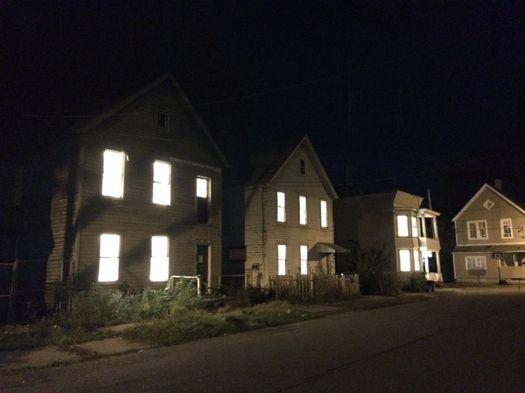
Stanley Street in Schenectady
The much-anticipated Breathing Lights project opens this weekend in Albany, Schenectady and Troy. For the next two months hundreds of vacant buildings in the three cities will be illuminated from the inside by gently pulsing lights as part of the public art installation.
The project is backed by up to $1 million in funding from the Bloomberg Philanthropies, and it won out over more than 200 other entries in a national competition for public art projects.
Here's a quick overview, along with some thoughts at the start of the project's public phase...
The setup
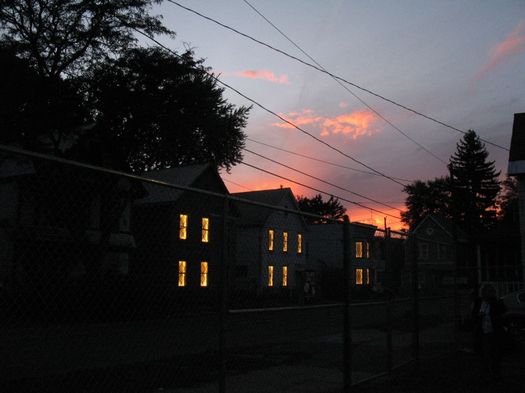
Two years ago the Bloomberg Philanthropies announced a national program to fund temporary public art projects around the country. The call resulted in 237 cities applying -- including a joint application from the cities of Albany, Schenectady, and Troy. The Capital Region's proposed project -- Breathing Lights -- was one of four chosen to get up to $1 million in funding. (The others: Gary, Indiana; Spartanburg, South Carolina; Los Angeles.)
From the Breathing Lights about page:
This unprecedented, multi-city installation will transform public streets into an evocative experience and provide a platform to reinvigorate partners around the Capital Region's most visible symptom of decades of disinvestment. Working with dozens of community and private-sector partners, Breathing Lights includes eight months of programming and events, including youth media projects, building reclamation clinics, community arts presentations, gallery talks, policy discussions and more. At the end of the installation, windows - one by one - will fall dark. In sharing a sense of loss comes a stir to action.
The two people originally behind Breathings Lights are Adam Frelin, the lead artist, and Barbara Nelson, the lead architect and community engagement director. Judie Gilmore, who previously worked with the famous Philadelphia Mural Arts Program, joined on as the project director.
The project also involves a bunch of related artworks, youth media projects, and neighborhood ambassadors.
A bunch of local orgs are also connected to help with the project, including the Community Foundation for the Capital Region, the Albany Barn, the Boys & Girls Clubs of Schenectady, and Sanctuary for Independent Media. Local donors have put up an additional $350k in additional resources.
The project says it hasn't used any public money.
The art
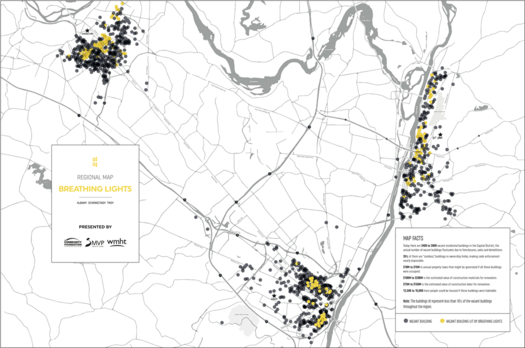
map: Breathing Lights
The artwork at the center of Breathing Lights is the illumination of the street-facing windows of hundreds of vacant buildings in Albany, Schenectady and Troy. (Here's a map of the locations.)
The illumination is created by strips of LED lights affixed around the frames of the windows, with plastic screens to diffuse the light. And the LEDs are attached to controllers that gently cycle the light levels up and down to mimic the idea of breath. (The project got an assist from the RPI's Lighting Research Center on some of the technical issues.)
At a kickoff event at the Schenectady Boys & Girls Club Thursday evening, Adam Frelin, the project's lead artist, said the idea is meant to conjure the feeling of occupancy in the buildings, while also anthropomorphizing the structures. The quiet, gentle pulsing demands the attention of the viewer, he said, prompting people to slow down and think.
In the glimpse we got of the project Thursday evening on Stanley Street in Schenectady's Hamilton Hill neighborhood, the effect of the installation was beautiful. There's something calming and meditative about the gentle pulsing of the light.
Frelin talked about seeing seeing the vacant buildings in different ways:
"I've been inside every building that we're lighting. I never know, when I open the door, what I'm going to find. I don't know if I'm just going to find an empty space, a burnt-out hull -- or clothes, photos, toys all just left behind because somebody had to leave in the middle of the night. These are deeply sad places. And at the same point these are places that have a lot of potential. These are places where new beginnings can start. I'm in some of these buildings and the person across the street comes over sometimes and says, 'How does it look inside there?' And I say it looks pretty good, and they say they think they're going to buy it. So I see both sides in the buildings."
The scale of the project is audacious -- to fit up hundreds of vacant homes in three cities, across multiple neighborhoods. Just pulling off the technical details and organization involved is remarkable.
"As an artist and an art professor, I can safely say that I've never been a part of a project like this," Frelin told the crowd. "And even more importantly, I don't know of a project like this. I feel like we've all gone into some uncharted territory on this one."
The challenge
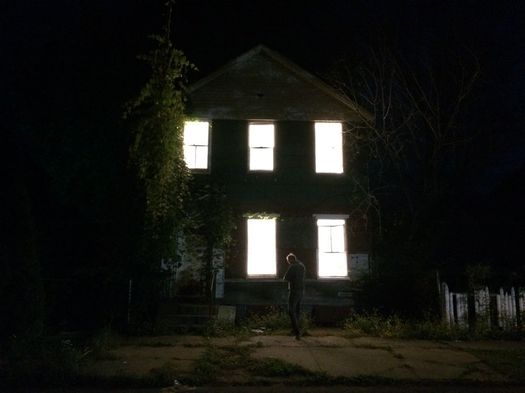
The hard part about all this is that Breathing Lights just ends being a beautiful spectacle, it won't be enough. The project's stated goal is to provide a platform for making progress on the vacant building issue. And, frankly, if it's going to use many of the Capital Region's often-underserved neighborhoods as a canvas, it owes the residents of these places a good-faith effort toward that end.
So there's a question that underlies this whole project: To what extent can art -- and the attention and awareness it brings -- make a difference?
Being skeptical about the value of raising awareness on vacant buildings in the Capital Region isn't an unreasonable position. Because this is a longstanding problem, and it's an issue that pops up all the time -- especially for the people who live in these cities and neighborhoods. How much more aware can we all collectively get?
But if this isn't so much about bring a new topic to the conversation, maybe there's something to changing the way we all talk about it.
"This project is about conversation, but it's even bigger than that because the conversation has already existed -- except the language was a little bit different," said Shawn McLean at Thursday's event. He's one of the neighborhood ambassadors for Troy. "The language was ugly. The language was drugs. The language was homeless people are in there doing things. Now because of the Breathing Lights project the language has turned. It's now about cultivation, it's now about development, it's now about the possibility. And one thing that art has always done is create the possibility of thought. And that's why this project means a lot to a lot of people here."
And sometimes people just need a prompt to talk to with each other. In her remarks Thursday, Albany mayor Kathy Sheehan pointed out how Breathing Lights has served as an opportunity for the three cities -- and people in each of them -- to explicitly work together:
"This project, it's not overstating it, has been transformational," she said. "Because it's allowed us three cities to work together in ways we never have before, to learn from one another about what's working in our communities, to have all the people in our cities who are passionate about these houses or passionate about affordable housing, passionate about neighborhood revitalization, to talk to one another. And they're talking to one another through this incredible medium of art."
It's not fair to expect Breathing Lights to fix the vacant building program in the Capital Region. In some ways, "vacant buildings" aren't even really the problem. They're the symptom of a whole host of underlying diseases that affect our communities, ranging from patterns of divestment, to racism, to complications in code enforcement. Expecting any one project to fix that is too much. There's a lot to untangle.
But the organizers of Breathing Lights, with all this attention shifted their way, do have a remarkable opportunity. And having now heard them talk about this project a few times, we get the sense they've given a lot of thought about making Breathing Light more than just a spectacle. That it can't just be The Very Cool Art Experience that grabs attention and then goes away.
The real test is in the actual doing, though -- and for everyone involved to hold the project accountable for accomplishing what it can.
As Shawn McLean, the neighborhood ambassador said, "My hope for this project is that this program will continue to develop thought, growth -- but more importantly, action."
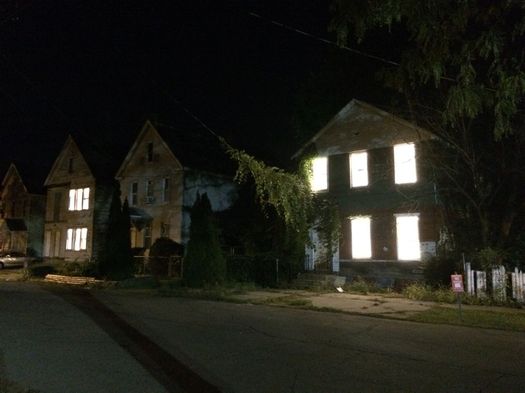
Watching the lights
After the event Thursday night we were standing on Stanley Street watching the lights and we got to talking with Rose Martinez, who lives around the corner. She'd seen the lights through her window and had come over to check them out. We talked about the neighborhood as kids ran and played on the blocked-off street.
"Besides the violence, it's a pretty good neighborhood once you get to the know the people," she said. "This neighborhood's kind of tough. We have people doing things they know they shouldn't be doing. So for attractions like this to catch someone's eye and say we need a change in Schenectady, I think that's really what needs to happen. Get the drug dealers off the street. Clean up Schenectady a little bit, especially this side of town."
Schedule
As mentioned, the illuminated buildings will be active each evening -- from 6-10 pm -- for the next two months. There are also many events planned, including weekends of events focused on individual cities:
+ September 30-October: Troy City Weekend
+ October 28-29: Schenectady City Weekend
+ November 4-5: Albany City Weekend
Hi there. Comments have been closed for this item. Still have something to say? Contact us.
Comments
Sorry but this is just ridiculous. Not as artwork but as a political statement or as any kind of meaningful statement at all. How is this different from when Jerry jennings wanted to stick plywood paintings in the windows?
Look, Albany has had decades to do something about vacant buildings. It is entirely - 100% - within local government's power to address this issue in a meaningful way. Most of these buildings are either in code violation (this the city of albany could act) or in county forclosure (thus the county could act).
If *either* mayor Kathy Sheehan or county executive Dan McCoy were worth anything at all as leaders they would work together to begin fixing this problem. But they do nothing.
In McCoy's case, his incompetence and corruption are obvious and disqualifying. No reason ever to hope for any change there.
Not sure what Sheehan's problem is since she's not obviously corrupt. Maybe just much more incompetent than we think. As we head into her reelection campaign I find myself asking how she is different in any way from Jerry Jennings.
... said Stan on Oct 3, 2016 at 3:23 PM | link
It's not only about what government can do about a longstanding urban challenge, and one that exists in most every city. It's also about raising awareness and changing public opinion about community development in these areas. And no, city government does not hold 100% of the solution. These complex problems require all hands on deck, public private partnerships.
Even small entrepreneurs like you and I can invest in and rehabilitate a home.
... said John Scicc on Nov 17, 2016 at 4:06 PM | link
@Stan, I couldn’t disagree more. Beyond the artful way this project has demonstrated the level of blight in our community, it has prompted people to talk (at least in my corner of the city) and this talk has led to meaningful discussion of the “politics†of blight and abandon properties (two distinct problems, mind you). It’s complicated, there are too many stakeholders to blame and plenty who get overlooked for their efforts, and requires long-term holistic measures. Already, this project has brought folks together to better tackle the issue, including unlikely actors, like suburban and rural partners who often discounted blight as a “urban†issue, but now are facing a growing number of once blighted homes that are have transitioned to being outright abandoned in their own jurisdictions. They are now working to have these abandoned properties transferred to the Albany Land Bank, so that would have been unthinkable years ago.
Yes, you have a fair point that government can do more. Firstly, however, local jurisdictions and counties are hamstrung by state and federal legalese, that make it difficult to offer profound and effective solutions to remediating abandoned properties, with the ultimate goal of getting them back on the tax roll. On the front end, they have limited means for offering inducements to get folks to remediate abandoned properties, or on the other end of the spectrum, they can punish them through zoning fees or taking the property via unpaid taxes/fees. On the back end, when the jurisdiction has taken the property and moved it into the foreclosure process, the burden of the property falls on the local government. It goes without saying, in our area at least, these jurisdictions either don’t have the resources or are subject to restrictions (like the tax cap on local taxes), that make it difficult for the jurisdictions themselves to remediate properties once they go into foreclosure, or face steep public criticism for holding deadweight on the books when it can be off-loaded to interested parties in the private sector. So at the end, we have a disposition policy that is being influenced by push and pull factors that dictate that we get the property into foreclosure via limited and ineffective tools and once in foreclosure, we quickly spit them out to the lowest bidder. The Land Bank, as has been demonstrated in countless communities, offers a unique opportunity for local government to off-load these foreclosed properties into a quasi-governmental entity that can work with the community to more effectively remediate and get property back on the tax rolls, and isn’t (as) hamstrung by the state/federal government in the solutions it can offer.
Secondly, we need to point our fingers to the private sector, which shares half the blame in my opinion. Present laws afford lots of protections to homeowners and banks, which make it difficult for government to do much about a abandon property (those that’s changing, like with the recent “Zombie Property†laws going on the books). In my own corner, I have one abandon property that has been battling its way through the courts, as three siblings have been duking it out about who “owns†it for the past three years. The city has been fining them, which has prompted someone to at least keep up decent appearances, but the house is certainly worse for the ware. I have another property that is owned by a bank, and for some darn reason has sat on it for 2 years (most likely, I assume, to use the depreciating value of the home to right down their tax burden). The city has fined them, and they have paid, but they can right those fines off their taxes too (thanks Congress), so there is really no effective punishment that local government can offer. My mom, who lives in Colonie, has a home on her block (an increasing problem in suburbia, as poverty migrates from urban America) where the owner is deceased, but no one knows who gets the property now (nothing in the will) and it thus sits and withers.
So after rambling on here, I do think that this “art†installation has promoted some healthy discussion and made folks more aware of the complicated politics, and just as important, free market implications of home ownership, and how this all can lead to some nasty scenarios that require a lot of holistic work to remediate.
... said Bill on Nov 18, 2016 at 9:59 AM | link